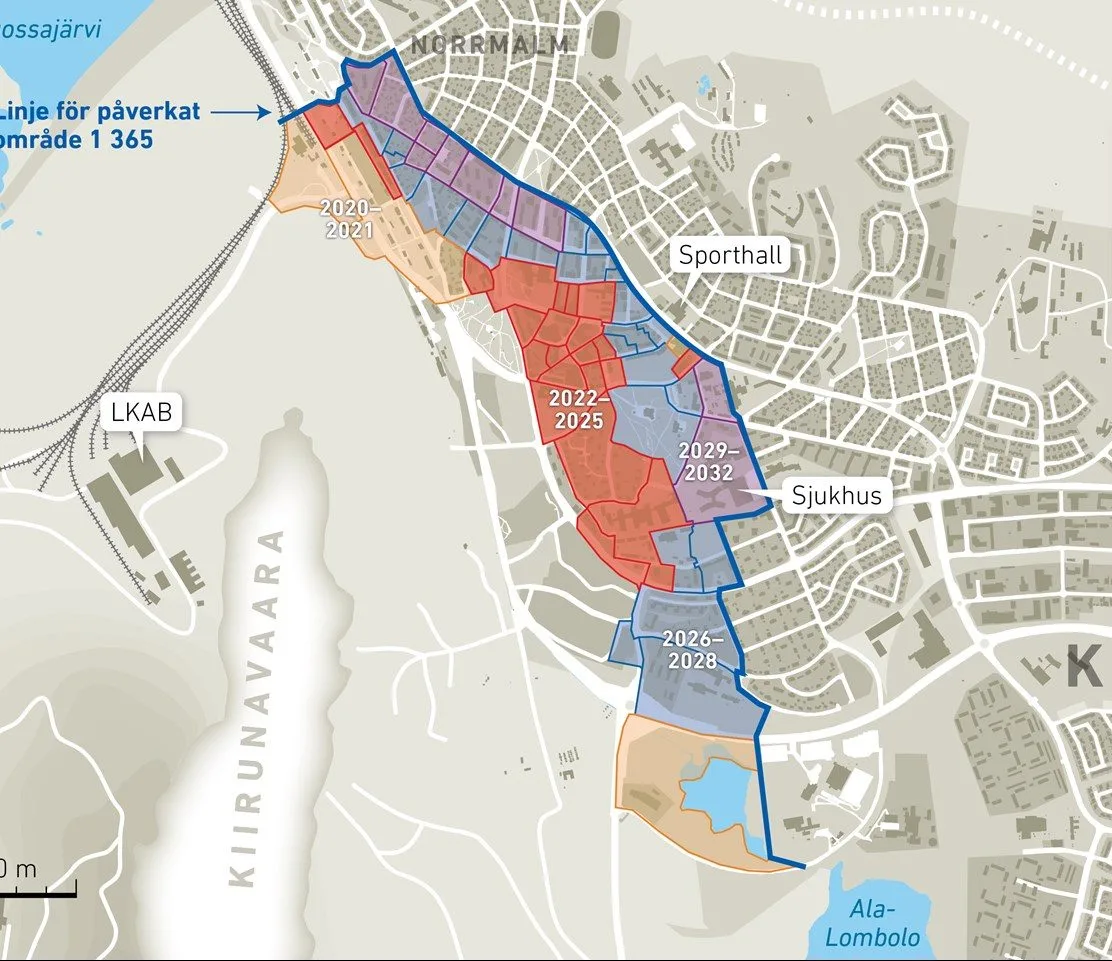Questions and answers
Here, we have gathered all the questions and answers that can help you along the way. You can filter by different topics to get a more relevant selection.
Check if your shop and business are concerned at “Time to move”, where you can find out if and, if so, when you will have to move.
Time to move Malmberget
Time to move KirunaBoth compulsory acquisition and expropriation mean that a property owner has to sell their building as a result of a decision by an authority. It is not something that LKAB can decide. LKAB only buys properties through voluntary purchase agreements. We do so when new areas are needed for mining or if the urban transformations mean that roads or other infrastructure are moved as a result of our operations.
The urban transformation process is developing all the time. Agreements already entered into apply and LKAB has been careful to treat everyone the same at any given time. Compensation amounts, conditions in the community and even the housing markets change as the years go by.
Business operators, authorities and organisations who relocate are compensated in several ways. Those who own their property are offered a replacement property and those who rent are offered new premises with an incremental rent plan for a period of up to five years. In addition, LKAB pays the relocation costs and loss of profit in connection with the move.
Read more about how LKAB compensates companies, authorities and organisations here.
People living in a tenant-owner apartment are compensated with a sum of money. LKAB’s offer is made up of two parts. The compensation is an amount per square metre of living space that corresponds to the square metre price for a newly built tenant-owner apartment in Malmfälten and an additional amount based on individual assessment of the condition and standard of the present apartment.
This allows the association’s members to choose between buying a newly built tenant-owner apartment in Malmfälten with the money they get from LKAB or doing what they want with the money. It’s important for us that the individual can choose to move to a new home.
Read more about private housing cooperative owners’ compensation here.
Tenants who do not own a property have priority option on both older and new homes. They will also be compensated through an incremental rent scheme that begins with the tenant’s current rent the first year and then increases over a period of seven years. Tenants who have to move are covered by LKAB’s scheme regardless of landlord.
House owners and property owners who own rental apartment buildings are offered a choice between a replacement building that is equivalent to their present one or a sum of money amounting to the property’s market value plus 25 per cent. The new building will not be a copy of the old one either as regards architecture or material. But it will be comparable. LKAB collaborates with various construction contractors and will order a new building if the owner chooses a replacement building instead of money.
Read more about house owners’ compensation here.
Read more about apartment building owners’ compensation here.
Those are the areas that are affected first. Above all it’s the infrastructure in the ground, e.g. water and sewage pipes, that breaks first.
No. LKAB has to use its resources and funds to resolve the situation in the areas that are next in line.
That level in the local plan is dependent on so many factors that it can’t be decided too far in advance. It depends on when the ground begins to affect an area, individual property owners’ situation, infrastructure, and many other things.
First, LKAB has to buy the property. It does so through voluntary agreements with property owners who have decided to sell. When the property has been sold, the person doesn’t have to move immediately. They can stay in their home as a tenant on a short-lease contract with LKAB’s subsidiary LKAB Fastigheter.
Check if you are concerned at “Time to move”, where you can find out if and, if so, when you will have to move.
Time to move Malmberget
Time to move KirunaThe mine and the surrounding area are monitored by an extensive system of geophones located underground and metering equipment placed above ground. Factors that affect the movement of the ground include the shape of the ore body, how we plan to mine it, what the bedrock that is affected looks like and how the actual ground movement spreads.
LKAB’s mining method, sub-level caving, means that cavities, known as voids, arise in the rock when the ore is mined. The voids are then filled with waste rock that falls down. This automatic filling means that the more ore that is mined the more the rock above subsides. The ground level is affected, ultimately resulting in deformations.
A local plan defines how land and water are to be used and how the built environment are to look inside a certain area in a municipality. Only the municipality can draw up and adopt a local plan, in other words change how an area is to be used.
The urban transformations assume that LKAB and the municipalities agree on how to make the transformations and who is responsible for what. The agreements are regulated in collaboration and implementation agreements. The agreements state what is to be moved, demolished and constructed. This involves complex planning and close collaboration between a number of parties. New homes, services and infrastructure must be ready or under construction before LKAB can close existing urban areas. In summary this means that there is first a great deal of planning, followed by the municipalities adjusting their local plans, and then construction of new communities for people to move to. The old buildings are then demolished or moved and the area becomes a green space before being turned into an industrial area.
We can’t say exactly because we don’t know how long the urban transformations will continue. In both Kiruna and Malmberget it’s a matter of several billion.
Since 2006 to December 2018 we have set aside about SEK 17 billion for the urban transformations and paid out about 11.3 billion.
LKAB pays for everything that is affected. The Swedish Minerals Act states that mining companies that cause damage to the surrounding area must pay for the damage. LKAB will therefore pay the major part of the cost of the urban transformations in Malmberget and Kiruna. Other players will pay some of the cost themselves because they will be talking the opportunity to construct new buildings or convert existing ones when the communities change.
They will continue until at least 2035, when the present main levels will have been worked out. If LKAB decides to proceed deeper down into the mines the urban transformations will continue.


Is there a timetable for my property?
On the page "Timetable for selling and moving", you can find more information about when different parts of our operational areas in Kiruna and Malmberget/Gällivare will be affected.
We are available to assist you
Get answers to your questions about the timetable, relocation destination, and the process by contacting us.

